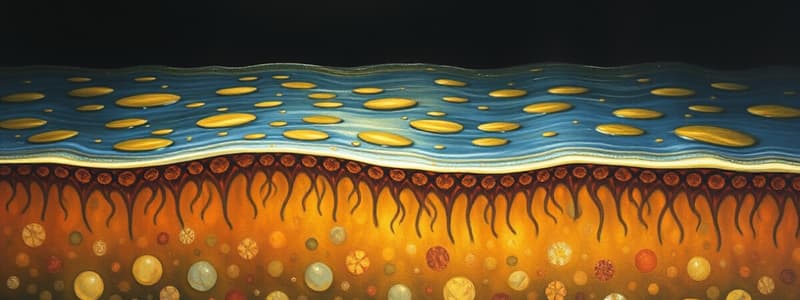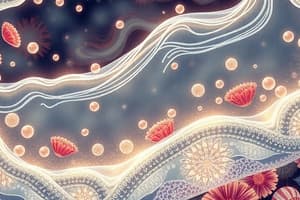Podcast
Questions and Answers
What is the main role of cholesterol in biological membranes?
What is the main role of cholesterol in biological membranes?
- To enhance fluidity and stability (correct)
- To decrease permeability to all substances
- To act as a transport protein
- To increase membrane thickness
Which transport mechanism requires energy input?
Which transport mechanism requires energy input?
- Active transport (correct)
- Osmosis
- Facilitated diffusion
- Simple diffusion
What determines the affinity of a protein for its ligand?
What determines the affinity of a protein for its ligand?
- The number of substrate molecules present
- The size of the protein
- The presence of competitive inhibitors
- The structure and functional groups of the binding site (correct)
What does the term 'Km' refer to in enzymatic reactions?
What does the term 'Km' refer to in enzymatic reactions?
Which part of an enzyme is specifically responsible for binding to the substrate?
Which part of an enzyme is specifically responsible for binding to the substrate?
How do enzymes facilitate chemical reactions?
How do enzymes facilitate chemical reactions?
What characterizes facilitated diffusion?
What characterizes facilitated diffusion?
In what manner do enzymes in a common pathway function?
In what manner do enzymes in a common pathway function?
Which statement accurately describes the concept of isotopes?
Which statement accurately describes the concept of isotopes?
What property of water is primarily responsible for its ability to moderate temperature?
What property of water is primarily responsible for its ability to moderate temperature?
Which type of bond is characterized by the sharing of electrons between atoms?
Which type of bond is characterized by the sharing of electrons between atoms?
In the context of water's polarity, what does electronegativity refer to?
In the context of water's polarity, what does electronegativity refer to?
Which of the following statements best describes hydrophilic and hydrophobic substances?
Which of the following statements best describes hydrophilic and hydrophobic substances?
What role do weak chemical bonds play in biological processes?
What role do weak chemical bonds play in biological processes?
What is the significance of using moles as a unit in chemistry?
What is the significance of using moles as a unit in chemistry?
Study Notes
Membrane Fluidity and Structure
- Fatty acid composition and cholesterol content regulate membrane fluidity.
- All biological membranes display asymmetry in their structure.
- Membrane structure serves a functional role as a selectively permeable barrier.
Molecule Transport Mechanisms
- Certain molecules can diffuse through the lipid bilayer, while others require transport proteins.
- Facilitated diffusion involves transport proteins (channels or carriers) and does not consume energy.
- Active transport requires energy, specifically from ATP hydrolysis, to move molecules against their concentration gradient.
Membrane Potential and Signaling
- Active transport is essential for maintaining membrane potentials, crucial for cellular signaling processes.
Protein Function and Ligand Binding
- Protein function is largely based on the ability to bind specific molecules, known as ligands.
- Affinity indicates the strength of interaction between a protein and its ligand.
Enzymatic Activity
- Enzymes are a type of protein that catalyze biochemical reactions by lowering activation energy.
- Active sites of enzymes consist of a substrate binding region and a catalytic region.
Enzyme Kinetics
- Reaction rate plots against substrate concentrations reveal important kinetic parameters: Km (Michaelis constant) and Vmax (maximum reaction velocity).
- Enzymes involved in a shared metabolic pathway are typically localized within specific cell compartments and can be associated as domains.
Matter and Chemical Elements
- Matter is made up of chemical elements, existing as pure elements or combined as compounds.
- Essential elements for life: carbon, oxygen, hydrogen, and nitrogen, collectively make up 96% of living organisms.
Atomic Structure
- Atomic number indicates the number of protons in an atom.
- Isotopes of an element consist of the same number of protons but vary in neutron count; some isotopes are unstable and can undergo radioactive decay.
Electron Configuration
- Electrons occupy specific energy levels around the nucleus of an atom, each with distinct energy characteristics.
- Strong chemical bonds include:
- Covalent bonds: formed through electron sharing between atoms.
- Ionic bonds: formed through the transfer of electrons from one atom to another.
Weak Chemical Bonds
- Weak bonds play a crucial role in biochemical interactions:
- Van der Waals interactions: arise from transient localized changes in electron density.
- Hydrogen bonds: occur when a hydrogen atom covalently bonded to an electronegative atom is attracted to another electronegative atom.
Chemistry and Biology
- Understanding biological processes can be enhanced by applying chemical principles and tools.
Properties of Water
- Water is a polar molecule due to the unequal distribution of electrons, giving oxygen a slight negative charge and hydrogen a slight positive charge.
- The polar nature leads to significant molecular attractions, resulting in:
- Cohesion: the attraction between water molecules.
- Temperature moderation: water can absorb and release heat without drastic temperature changes.
- Solvency: water's ability to dissolve various substances.
Hydrophilic vs Hydrophobic
- Hydrophilic substances interact favorably with water.
- Hydrophobic substances do not interact with water and tend to repel it.
Measuring Concentrations
- The mole is an important unit for quantifying the amount of solute present in solutions, facilitating the understanding of concentrations in chemical and biological contexts.
Studying That Suits You
Use AI to generate personalized quizzes and flashcards to suit your learning preferences.
Description
This quiz covers essential concepts about cell membrane fluidity, composition, and transport mechanisms. You'll explore how the arrangement of fatty acids and cholesterol affects membrane function, as well as the differences between passive and active transport. Test your understanding of how these processes are vital for cellular function.




